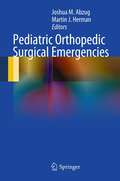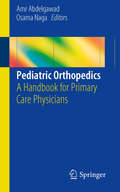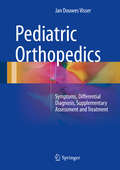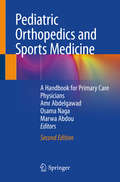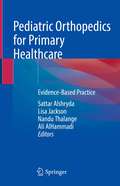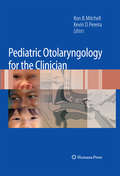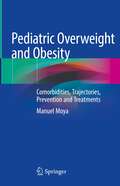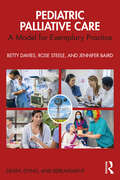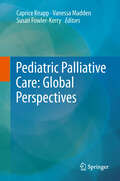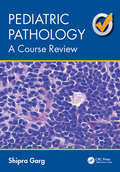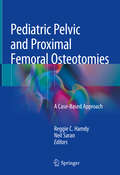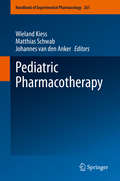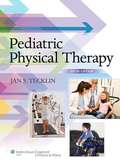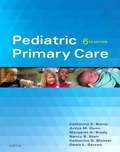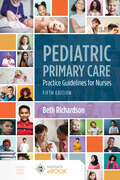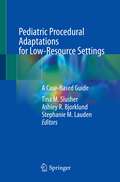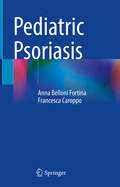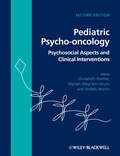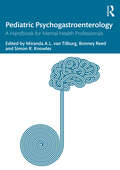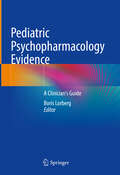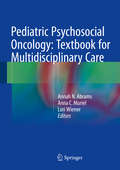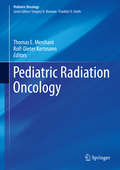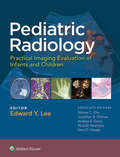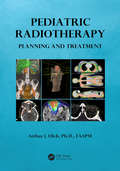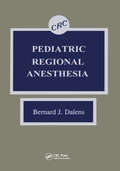- Table View
- List View
Pediatric Orthopedic Surgical Emergencies
by Martin J. Herman Joshua M. AbzugEmergency care of pediatric orthopedic surgical emergencies is often provided by orthopedic surgeons who primarily treat adults. Pediatric Orthopedic Surgical Emergencies is designed to provide the essential information needed to safely evaluate and treat the most common surgical emergencies in pediatric orthopedic surgery. Each emergency scenario includes the keys to patient evaluation, operative considerations, and expected complications. Each contributor provides technical pearls and tips based on their preferences and clinical experience in this area. Topics covered run the gamut from trauma (including the mangled extremity and compartment syndrome) to individual body regions (the spine, upper and lower extremities) to infection and other conditions. Pediatric Orthopedic Surgical Emergencies is a convenient, illustrated guide to procedures that can be challenging to those physicians who treat pediatric patients infrequently.
Pediatric Orthopedics
by Amr Abdelgawad Osama NagaTopics in pediatric orthopedics routinely surface in general pediatrics and primary care, whether on board exams or in clinical practice. From birth injuries to musculoskeletal infections, there are many conditions and presenting complaints that must be addressed by the primary care physician or pediatrician. This concise and targeted handbook contains just the need to know conditions, injuries, and diseases necessary for residents and even seasoned clinicians to brush up on pediatric orthopedic topics with ease. Information is contained within themed chapters (like neuromuscular diseases or musculoskeletal infections) and also by anatomical region (hip, knee foot, spine, etc. ). This book gives readers the basic knowledge to be able to identify common orthopedic conditions, indications to either treat these conditions or refer patient to an orthopedist, and covers the entire required curriculum needed to answer musculoskeletal questions on the pediatrics board exam.
Pediatric Orthopedics
by Jan Douwes VisserThis book presents the most common site-specific pediatric orthopedic problems seen in clinical practice. Detailed discussions of disorders of the chest wall, neck, back, pelvic, upper- and lower limb, leg length discrepancy, abnormal gate, congenital deficiencies, bone and joint infections are included in this comprehensive resource. Operative treatments are discussed throughout the book with the key focus on managing the patient and the use of the conservative approach. As such, the main benefit of this book is as a diagnostic tool to assess children with orthopedic disease. Designed to lead the reader from the initial physical examination through to making the most likely diagnosis, there is advice on what additional studies are meaningful, when there is an indication for referral and what advice can be provided for the patient. The value of the book is increased by hundreds of color images, thus making it easily accessible for pediatric orthopedic surgeons, pediatricians, pediatric physiotherapists, podiatrists, pediatricians, rehabilitation specialists and primary care physicians with an interest in the subject.
Pediatric Orthopedics and Sports Medicine: A Handbook for Primary Care Physicians
by Amr Abdelgawad Osama Naga Marwa AbdouThe revised and the expanded second edition of this concise and targeted handbook presents the “need-to-know” musculoskeletal conditions and injuries required for all health care providers dealing with pediatric patients, including primary care physicians, emergency medicine physicians, radiologists, residents, students, nurses, and therapists, to brush up on pediatric orthopedics and sports medicine topics with ease. The most up-to-date information is contained within themed chapters--sports injuries and pediatric trauma, for example--as well as by anatomical region--the hip, knee, foot, spine, etc.--including chapters new to this edition covering pediatric musculoskeletal image interpretation and general aspects of sports medicine.This book addresses high-yield points needed for both general day-to-day pediatric orthopedics and sports medicine practice as well as information needed for the musculoskeletal section of the General Pediatrics Certifying Examination and other board exams for other specialties, physician assistants, nurse practitioners, and physical therapists. Well-illustrated and utilizing an easy-to-follow, bullet-pointed format, Pediatric Orthopedics and Sports Medicine gives the reader the basic knowledge to be able to identify and understand the management of common pediatric orthopedic and sports medicine conditions, and indications to either treat these conditions or refer the patient to an orthopedist.
Pediatric Orthopedics for Primary Healthcare: Evidence-Based Practice
by Lisa Jackson Sattar Alshryda Nandu Thalange Ali AlHammadiThis book provides a comprehensive, evidence-based guide on how to manage pediatric orthopedic problems safely and confidently. The format allows the reader to identify key points whilst working in their busy clinical practice. Each chapter is co-written by an orthopedic surgeon and general practitioner to ensure the content is relevant to primary care, but also sufficiently detailed to meet the needs of those in specialist training. The book is divided into two parts; general topics including assessment, normal variants, infections and specific disorders; followed by a section based on specific anatomical regions. Pediatric Orthopedics for Primary Healthcare: Evidence-Based Practice will be an essential resource for a wide audience including but not limited to general practitioners and trainees, pediatric orthopedic surgeons, trauma surgeons, orthopedic residents, emergency department doctors, physiotherapists, podiatrists and medical students who are seeking a concise, yet comprehensive evidence-based resource for this important specialty.
Pediatric Otolaryngology for the Clinician
by Ron B. Mitchell Kevin D. PereiraOver the last 20 years, pediatric otolaryngology has become a recognized subspecialty within otolaryngology head and neck surgery. Organizing the growth of clinical practice and knowledge in this area now is Pediatric Otolaryngology for the Clinician, a user-friendly resource for practicing general otolaryngologists, pediatricians and family practice physicians. This important title is divided into five sections: general ENT topics, otology, rhinology, head and neck disorders, and emergencies. Each chapter is authored by a recognized expert in the field and is concise and highly informative. Designed as a quick reference guide on a variety of topics such as antibiotic treatment of ear infections, sleep disorders in children, cochlear implantation, and airway management, to name just several, the book serves as a comprehensive yet succinct guide to caring for children with ear, nose and throat problems and will stand as an invaluable resource for any busy pediatric clinic.
Pediatric Overweight and Obesity: Comorbidities, Trajectories, Prevention and Treatments
by Manuel MoyaThis book focuses on the worldwide frequent and growing problem with its projective trajectory that encompasses pediatric overweight and obesity. Through the ten chapters it offers in the first four a comprehensive state of art of the bases of pediatric obesity in order to support the following ones with new and proved clinical issues, as recent complementary features on anthropometry and food intake and new safe treatments. This books discusses comorbidities, trajectories, prevention, extended periods and treatment. For effective prevention, clues are given to routinely screen all comorbidities that are already present in overweight or obese children but frequently overlooked.This volume will be of benefit to pediatricians, endocrinologists and all healthcare providers interested in the care of children and adolescents.
Pediatric Palliative Care: A Model for Exemplary Practice (Series in Death, Dying, and Bereavement)
by Jennifer Baird Betty Davies Rose SteelePediatric Palliative Care: A Model for Exemplary Practice lays out a road map for health-care providers interested in optimizing care for seriously ill children and their families. Grounded in clinical practice and the study of positive rather than problematic encounters between providers and parents, the book presents an evidence-based model of exemplary interaction. The chapters offer a clear understanding of the complex, holistic process of interaction between providers and parents, as well as the personal and professional knowledge and skills needed to interact in optimal ways. This is a one-of-a-kind guidebook for health-care providers interested in (re)discovering how to maximize positive outcomes for both families and providers. It is also a valuable source of inspiration for educators, supervisors, and hospital administrators who want to facilitate personal and professional development and create supportive environments for students, providers, seriously ill children, and their families.
Pediatric Palliative Care: Global Perspectives
by Susan Fowler-Kerry Vanessa Madden Caprice KnappThe first of its kind, this book describes pediatric palliative care in more than 23 countries. Each region in the world is covered and countries included are both resource poor and rich. Authors are multidisciplinary and regarded nationally and internationally in their field. Clinicians, advocates, policymakers, funders, and researchers will learn how programs were developed and implemented in each country. Authors describe children for whom pediatric palliative care is needed and provided for in their country. When applicable, a brief history of pediatric palliative care is included noting especially policy changes and legislative acts. For example, the chapter on Poland describes how pediatric palliative care grew from the Catholic church into a national movement spearheaded by several health care workers. The Pole national spirit that brought them through a change in political regime has also been a driving force in the pediatric palliative care movement. The chapter on South Africa, for example, illustrates how a resource poor country has been able to leverage philanthropic and government funding to make its dream of having an infrastructure of pediatric palliative care a reality. These are just a few examples of the inspiring stories that are included in this book. Readers from countries who wish to start a pediatric palliative care program, or advance an existing program, will learn valuable lessons from others who have faced similar barriers. Introduction and concluding chapters highlight the strengths and weaknesses of the modern pediatric palliative care movement.
Pediatric Pathology: A Course Review
by Shipra GargThis book serves as a quick study guide during the stages of examination preparation for the pediatric pathology boards. The material covers most of the major topics in pediatric pathology including the fetal, perinatal, infant, child, and organ system pathology. It includes a short quiz containing 115 questions with photomicrographs for each, and an answer key inserted at the end of the book.
Pediatric Pelvic and Proximal Femoral Osteotomies: A Case-based Approach
by Reggie C. Hamdy Neil SaranThis unique, case-based text offers a comprehensive discussion of pelvic and proximal femoral osteotomies in the pediatric population. Beginning with chapters on preoperative planning and radiologic evaluation of the adolescent hip, subsequent chapters are sensibly divided into three thematic sections, which use a consistent chapter format presenting the case history, relevant imaging, treatment goals, the management strategy, and clinical pearls and pitfalls. Part I describes the various pediatric pelvic osteotomies, including the Salter, Pol de Coeur, Tönnis, Pemberton, and San Diego approaches, among others. Pediatric proximal femoral osteotomies comprise part II, presenting the McHale procedure, varus and valgus osteotomies, Morscher osteotomy, and Shepherd’s Crook deformity, to name just a few. The final section covers combined and miscellaneous osteotomies and procedures for the pediatric hip, such as osteochondroplasty, hip instability, hip arthrodesis, and SUPERhip and SUPERhip2 procedures for congenital femoral deficiency. Each chapter is generously illustrated and includes a handy table of indications and contraindications for the procedure described.In infancy, childhood and adolescence, the hip joint is very susceptible to abnormalities (congenital or acquired) that may lead to morphological alterations with potential sequelae, specifically pain and difficulty to ambulate, sit and perform daily activities. Restoring normal anatomy and biomechanics of the hip joint by various pelvic and/or proximal femoral osteotomies remains the cornerstone in the management of these conditions. To this end, Pediatric Pelvic and Proximal Femoral Osteotomies will be an invaluable resource for all pediatric orthopedic surgeons, trainees and students both in the medical and paramedical field.
Pediatric Pharmacotherapy (Handbook of Experimental Pharmacology #261)
by Wieland Kiess Matthias Schwab Johannes van den AnkerThis volume provides readers with the most updated scientific information on the efficacy and safety of medicines for children and adolescents. The book enriches the understanding of pediatric pharmacotherapy for health professionals, regulatory agencies, pharmaceutical companies and learned societies. It contains important information on the pharmacodynamics and pharmacokinetics of drugs. It summarizes the latest investigations on the effects of pharmacological treatments in relation to and dependent on age, gender, fat mass and disease status. Therefore and importantly, this volume reviews the latest data on how pharmacotherapy has to be adjusted and personalized in regards to stages of development and during the pediatric lifespan from neonate through adolescence. In addition, the topic of rare diseases and special challenges for pharmacotherapy will be included and will provide readers with the necessary knowledge to handle complex diseases and treatment strategies especially in relation to pharmacotherapy of rare and orphan diseases.
Pediatric Physical Therapy Fifth Edition
by Jan Stephen TecklinThis fifth edition of Tecklin’s Pediatric Physical Therapy Pediatric Physical Therapy provides basic medical information regarding common clinical diagnostic categories, followed by coverage of physical therapy evaluation, treatment, and special issues within each diagnostic group.
Pediatric Primary Care
by Catherine Burns Ardys Dunn Margaret Brady Nancy Starr Catherine Blosser Dawn Garzon Nan GaylordGet an in-depth look at pediatric primary care through the eyes of a Nurse Practitioner! Pediatric Primary Care, 6th Edition guides readers through the process of assessing, managing, and preventing health problems in infants, children, and adolescents. Key topics include developmental theory, issues of daily living, the health status of children today, and diversity and cultural considerations. This sixth edition also features a wealth of new content and updates - such as a new chapter on pediatric pharmacology, full-color design and illustrations, new QSEN integration, updated coverage of the impact of the Affordable Care Act, a refocused chapter on practice management, and more - to keep readers up to date on the latest issues affecting practice today.
Pediatric Primary Care: Practice Guidelines for Nurses
by Beth RichardsonPediatric Primary Care: Practice Guidelines for Nurses, Fifth Edition is a comprehensive resource for well-child management and acute care management of childhood illnesses in a primary care setting. Written by practicing experts, this text is intended for advanced practice nursing students as a quick reference guide once they enter clinical practice. To manage initial and follow-up visits, the Fifth Edition features templates for gathering first visit history, as well as a template to record new information since the last visit. Instructions for gathering medical history information are also included.
Pediatric Procedural Adaptations for Low-Resource Settings: A Case-Based Guide
by Tina M. Slusher Ashley R. Bjorklund Stephanie M. LaudenDespite global advancements in pediatric medicine, technologies which have become standard-of-care in high-resource settings are unavailable in low-and middle-income countries due to cost, availability, or challenges maintaining equipment. This book compiles evidence-based and expert clinical procedural adaptations in an approachable, case-based, step-by-step guide, aimed to provide educational support for healthcare providers practicing in resource-limited settings. This responds to both the high demand for this content and the importance of gathering experts across continents and pediatric disciplines. Each chapter provides both a theoretical framework and practical discussion of high-yield procedural adaptations. Leading international researchers and seasoned clinicians with expertise using these adaptations were selected by the editors as authors. Chapters include an example case with adaptation use and detailed instructions including supplies, indications, risks, and benefits. Content is grounded in current best practice recommendations and evidence-based research. Highlighted by the COVID-19 pandemic, a mature understanding of pathophysiology and device design/safety is required when providing care in low-resource settings or in crisis times. In-person instruction is not always feasible. Written and virtual platforms remain critical in disseminating high-yield, practical content. This book is not a substitute for appropriate procedural training, though is easily modified to meet the educational needs of diverse learner groups. It is a valuable resource for appropriately trained practitioners practicing in accordance with local guidelines. Knowledge and fluency with pediatric procedural adaptations is critical in efforts to reduce global inequities and pediatric morbidity/mortality in low-resource settings.
Pediatric Psoriasis
by Anna Belloni Fortina Francesca CaroppoThis book focuses on childhood psoriasis; it comprehensively discusses various concepts and topics related to this widespread auto-immune disease, including its pathogenesis, clinical aspects, the most recent and proven therapeutic approaches as well as the management of the psychological burden generated in younger patients. By highlighting the latest information on the pathogenic mechanisms, this unique book illustrates the great variety of clinical manifestations of this condition in pediatric patients, which are often very different from those in adults and later onset cases. It describes state-of-the-art therapeutic approaches and the advantages and limitations of latest treatment options available, and also presents all comorbidities of the disease in childhood, focusing on cardiovascular and metabolic disorders, as well as on the psychological impact of the disease in both children and adolescents. Including over 90 original full-color illustrations, this book raises dermatologists’ and pediatricians’ awareness of this disease, which is increasingly being diagnosed during childhood. It also provides practical tools for best management. This clear, concise guide is intended for dermatologists, pediatricians, clinicians and researchers as well as residents in dermatology and pediatrics, but will appeal to all readers wanting to update their understanding of psoriasis in childhood.
Pediatric Psycho-oncology
by Shulamith Kreitler Andrés Martin Myriam Weyl Ben-ArushLike the ground-breaking first edition, Pediatric Psycho-oncology, Second edition puts the child at the centre of medical and psychological care. It broadens the focus beyond treatment and cure to consider the quality of life of the child and their family. Written by an international group of pediatric oncologists and psychologists/psycho-oncologists brought together by an expert editorial team, it focuses on the real-life practical aspects of children undergoing treatment for cancer.This edition has been restructured and opens with a major section on Active treatment, which includes chapters addressing quality of life, pain, psychosocial aspects of treatment and interventions, art therapy and different fantasy-based techniques, palliative care, communication and education, as well as a new chapter on psychopharmacology. Shorter sections then discuss survivorship and care of the dying child, including a new chapter on bereavement. The final section comprises new chapters on ethical considerations and on addressing the emotional needs of children whose parents have cancer, as well as a case study on international collaboration. An appendix provides a comprehensive overview of tools for evaluation and assessment in pediatric psychooncology.This book is a highly practical resource that will be invaluable for all health care professionals looking after children and adolescents with cancer.
Pediatric Psychogastroenterology: A Handbook for Mental Health Professionals
by Miranda A.L. van Tilburg, Bonney Reed and Simon R. KnowlesBringing together international experts in psychological and behavioural treatments for pediatric gastrointestinal symptoms, this book provides detailed, evidence-based protocols targeting gastrointestinal distress and associated mental health concerns for patients and their families. The first consolidated resource on the topic, Pediatric Psychogastroenterology gives mental health professionals access to the most up to date clinical knowledge and practice. Taking a holistic approach, it guides the reader on the treatment and care of pediatric gastrointestinal patients, as well as how to work with and support children’s parents and families. The book is structured around symptom presentation and common challenges, enabling the reader to focus quickly on the area of need. Each chapter includes clinical pearls of wisdom and 62 developmentally appropriate worksheets for patients and their families to facilitate treatment, available for download. This practical, authoritative guide is an essential resource for mental health professionals who work directly with pediatric cohorts, as well as postgraduate students in health psychology, behavioral medicine, or social work.
Pediatric Psychopharmacology Evidence: A Clinician's Guide
by Boris LorbergThis book is a comprehensive guide to pediatric psychopharmacology, detailing medications used to treat a wide variety of childhood and adolescent mental illnesses. Childhood and adolescence represent critically important life stages in cognitive, social, and emotional development. Unfortunately, the prevalence of mental illness has been growing over the last several decades, especially among children. It is estimated that suicide is the second most common cause of death among adolescents and young adults in the United States. A crucial component of evidence-based mental health treatment of youth consists of careful, sophisticated, and compassionate medication treatment. This guide is divided into 18 chapters, with most covering the medications used to treat a specific disorder or group of disorders. Chapters comprehensively cover each medication’s history, FDA indication status and context, representation in the media, mechanism, extent of usage and research, and quality of evidence supporting its efficacy and safety. Chapters also cover approaches clinicians can use to discuss medications with patients—including alternative treatment options and integrating patient-level variables when choosing a medication. This book focuses on understanding patient and family perspectives on medication with suggested clinician responses to better communicate about prescription management. Chapters also include tables and figures, list resources and guidelines, and discuss controversies in the media. All prescribers to children and adolescents will find Pediatric Psychopharmacology Evidence to be a timely, comprehensive, and compassionate guide to the pharmacological treatment of young patients with mental illness.
Pediatric Psychosocial Oncology: Textbook for Multidisciplinary Care
by Annah N. Abrams Anna C. Muriel Lori WienerThis textbook walks clinicians through the psychosocial issues and challenges faced by children and adolescents with cancer and their families. Through a developmental lens, the text provides guidance and resources that will enable clinicians to understand the physical and emotional impact of the disease from diagnosis onwards, to work with families in distress, and to diagnose and treat a range of behavioral, psychological, and psychiatric issues. The book also addresses the burgeoning fields of social media, complementary therapies, palliative care, and survivorship. Among the variety of useful resources supplied are assessment tools, websites, and additional reading materials. The psychosocial issues that arise for children and their families during the course of treatment are an important yet often overlooked aspect of pediatric oncology care. The reader will find that Pediatric Psychosocial Oncology: Textbook for Multidisciplinary Care covers these issues at the forefront of clinical care in a direct and approachable way, integrating research literature with practical clinical guidance.
Pediatric Radiation Oncology (Pediatric Oncology Ser.)
by Thomas E. Merchant Rolf-Dieter KortmannThis book presents the most up-to-date and innovative information on the targeting and treatment of a wide range of childhood cancers by means of radiation therapy. Written by global experts in pediatric radiation oncology, it documents in detail the treatment regimens appropriate to each disease, highlighting the recent advances that promise to improve rates of survival and cure. The use of image-guided and intensity-modulated radiation therapy is clearly described, and careful attention is also devoted to the roles of proton therapy, stereotactic radiosurgery, stereotactic fractionated radiosurgery, and modulated arc radiotherapy. Separate chapters address localization and verification procedures and anesthesia; pediatric radiation oncology in the palliative care setting; and aspects that are especially relevant in low- and medium-income countries. Beyond clinical radiation oncology, relevant information is provided on radiation physics. The book concludes by examining future directions in the field.
Pediatric Radiology: Practical Imaging Evaluation Of Infants And Children
by Edward LeeYour accessible guide to the essentials of pediatric diagnostic imaging! Pediatric Radiology: Practical Imaging Evaluation of Infants and Children provides vital insights on how to diagnose both common and rare, congenital and acquired disorders in infants and children using the best imaging approaches available today. And, it does so in a highly concise, practical manner that makes this information easy to understand and apply. Contributions from a host of respected international authorities put the most relevant, expert information from around the world at your fingertips.
Pediatric Radiotherapy Planning and Treatment
by Arthur J. OlchBy becoming knowledgeable about optimal treatment methods designed specifically for childhood cancers, members of a radiotherapy team can help improve both pediatric cancer survival statistics and patients' quality of life. Pediatric Radiotherapy Planning and Treatment is the first single, focused resource available for health care providers to acc
Pediatric Regional Anesthesia
by BernardJ. DalensThis book provides a precise description of safe and reliable procedures for regional anesthesia in children. It covers the advantages and disadvantages, specific features related to the pediatric range of ages, and the practical importance of the described procedures. Written in two main parts, emphasis is placed on scientific basis and technical approach. It includes both anatomical and psychological aspects of pain, as well as detailed viewpoints of parents, children, surgeons, and anesthetists. This book is a must for all anesthesiologists and will be particularly useful to students of medicine and anesthesiology and nurses working with intensive care units.
